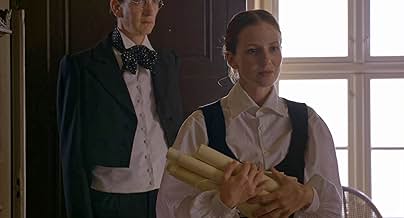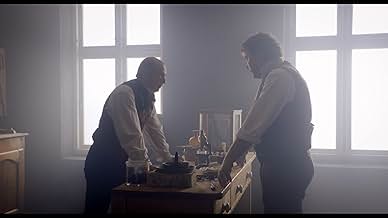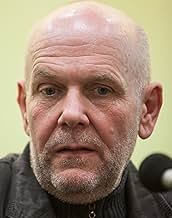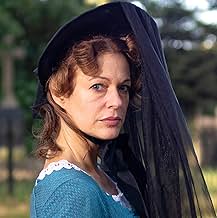IMDb RATING
7.3/10
3.9K
YOUR RATING
1828 in the German port city of Bremen: A female law clerk tries to prove her worth during the investigation of a series of poisonings.1828 in the German port city of Bremen: A female law clerk tries to prove her worth during the investigation of a series of poisonings.1828 in the German port city of Bremen: A female law clerk tries to prove her worth during the investigation of a series of poisonings.
- Director
- Writers
- Stars
- Awards
- 29 wins & 22 nominations total
- Director
- Writers
- All cast & crew
- Production, box office & more at IMDbPro
Featured reviews
The fact that this movie draws its inspiration from actual events significantly enhanced my enjoyment and appreciation of it. The filmmakers deserve commendation for their ability to present a narrative that not only engages but also incorporates a strong feminist perspective, executed both artfully and convincingly. The performances were exceptional, particularly those of the actress portraying the female serial killer and her counterpart, the nemesis character. Their portrayals were both compelling and immersive, adding depth to the storyline.
Additionally, the music score of the film was a standout feature. It complemented the mood and tone of the movie beautifully, weaving seamlessly with the narrative to enhance the overall experience. On the other hand, the subplot, which aimed to enrich the film by providing political context, fell somewhat short for me. Although it was an interesting addition, I found it somewhat elusive and challenging to fully grasp as an average viewer. This aspect didn't diminish my overall enjoyment of the film but was a noticeable contrast to the otherwise engaging storytelling.
Looking forward, I am genuinely excited and eagerly anticipating more work from the director, Udo Flohr. His unique approach to storytelling and his ability to bring complex characters to life are truly commendable, and I am keen to see how his future projects unfold.
Additionally, the music score of the film was a standout feature. It complemented the mood and tone of the movie beautifully, weaving seamlessly with the narrative to enhance the overall experience. On the other hand, the subplot, which aimed to enrich the film by providing political context, fell somewhat short for me. Although it was an interesting addition, I found it somewhat elusive and challenging to fully grasp as an average viewer. This aspect didn't diminish my overall enjoyment of the film but was a noticeable contrast to the otherwise engaging storytelling.
Looking forward, I am genuinely excited and eagerly anticipating more work from the director, Udo Flohr. His unique approach to storytelling and his ability to bring complex characters to life are truly commendable, and I am keen to see how his future projects unfold.
In this true story, two formidable women deliver impactful performances at the forefront. The narrative, if fabricated, would seem implausively exaggerated. It's unsettling to realize that the seemingly benign yet cunning woman who poisoned about 15 people over years in Bremen actually existed. I viewed this film in a German city close to Bremen, where locals are familiar with this historical incident.
In the movie, the murderess is depicted as jealous of the talents and status of her adversary, the young legal assistant Cato Böhmer. While there are some plausible theories about the murderer's motives and mindset, her actions largely remain an enigma, leaving viewers with lingering questions. What drove her to commit numerous murders while maintaining a facade of benevolence?
The film's dialogue stands out for its clarity, a refreshing change from modern movies that often feature mumbled lines or overpowering background sounds.
The score, created by a 40-member orchestra, beautifully enhances the film's mood.
The plot weaves in the technological and economic progress of the 1830s, educating viewers on railway development in Northern Germany against a backdrop of historical scenery. An intriguing aspect is the depiction of an early mechanical copier, a device I was unfamiliar with.
This movie is a must-see, transcending appeal beyond historical dialogue enthusiasts. I eagerly anticipate Udo Flohr's next creation and hope he continues to cast such compelling actors.
In the movie, the murderess is depicted as jealous of the talents and status of her adversary, the young legal assistant Cato Böhmer. While there are some plausible theories about the murderer's motives and mindset, her actions largely remain an enigma, leaving viewers with lingering questions. What drove her to commit numerous murders while maintaining a facade of benevolence?
The film's dialogue stands out for its clarity, a refreshing change from modern movies that often feature mumbled lines or overpowering background sounds.
The score, created by a 40-member orchestra, beautifully enhances the film's mood.
The plot weaves in the technological and economic progress of the 1830s, educating viewers on railway development in Northern Germany against a backdrop of historical scenery. An intriguing aspect is the depiction of an early mechanical copier, a device I was unfamiliar with.
This movie is a must-see, transcending appeal beyond historical dialogue enthusiasts. I eagerly anticipate Udo Flohr's next creation and hope he continues to cast such compelling actors.
10gareth33
The film's foundation in a true story significantly and it really impacted my admiration for it. Kudos for adeptly and artistically presenting the narrative with a robust feminist perspective. The custom-composed film score, executed by a 40-piece orchestra, is masterfully crafted and seamlessly aligns with the overall film ambiance. While not adhering to a modest budget, this isn't your typical Hollywood production, demanding your focused engagement. However, the investment is undeniably rewarding, even for those who aren't typically drawn to historical dialogues. Encountering films like this isn't a frequent occurrence, so I'm genuinely pleased to have come across it. I'll definitely make a point to recommend it to my family and friends.
It's astonishing that I only discovered this film today. "Effigy: Poison and the City" revolves around two formidable women who deliver incredibly convincing performances at the heart of this true story.
If the character of the murderess and her plot had been fictional, it would have strained credibility; it would have felt excessively dramatic. What makes it unsettling is that this seemingly mild-mannered yet cunning woman, who poisoned approximately 15 people over several years before her capture, actually existed in Bremen.
In the movie, the murderer appears to covet the talents and social status of her adversary, the young law clerk Cato Böhmer. While there are a few plausible interpretations of the killer's motives and psychological makeup, for the most part, her actions remain shrouded in mystery. This leaves you with plenty to contemplate afterward. It's a genuinely thought-provoking and highly entertaining experience.
If the character of the murderess and her plot had been fictional, it would have strained credibility; it would have felt excessively dramatic. What makes it unsettling is that this seemingly mild-mannered yet cunning woman, who poisoned approximately 15 people over several years before her capture, actually existed in Bremen.
In the movie, the murderer appears to covet the talents and social status of her adversary, the young law clerk Cato Böhmer. While there are a few plausible interpretations of the killer's motives and psychological makeup, for the most part, her actions remain shrouded in mystery. This leaves you with plenty to contemplate afterward. It's a genuinely thought-provoking and highly entertaining experience.
Two strong women play convincing roles in the foreground of this real life story.
If the murderess and her plot had been invented, this would hardly be credible, it would simply appear overdone. So the disturbing thing is that this apparently gentle but crafty woman, who poisoned around 15 people over several years before being caught, really existed in Bremen. I watched the film in a cinema in a city in Germany, not far from Bremen, and friends from there know the story from local history.
In the film, the murderess appears to envy the skills and social standing of her opponent, the young law clerk Cato Böhmer.There are a few understandable interpretations of the killer's motivation and psychological disposition, but by and large her actions remain a mystery, so you get something to ponder about afterwards. Why did she kill so many people and at the same time portray herself as a caring person?
The dialogues are enjoyable acoustically, in contrast to many current films, where it is apparently cool to mumble or to accompany the dialogues with loud background noises or music.
The specially produced film music, performed by a 40-piece orchestra, is wonderfully composed and fitting to the whole atmosphere of the film.
The criminal case is integrated into the technical and economic developments of the era around 1830. You learn about railroad construction in Northern Germany together with impressive historical backdrops. As an interesting detail, the use of a kind of mechanical copier is also shown (a device completely unknown to me).
It is a film well worth seeing, not only for fans of historical dialogues. I am already waiting for the next film from Udo Flohr and hope that he will continue to employ such powerful actors.
If the murderess and her plot had been invented, this would hardly be credible, it would simply appear overdone. So the disturbing thing is that this apparently gentle but crafty woman, who poisoned around 15 people over several years before being caught, really existed in Bremen. I watched the film in a cinema in a city in Germany, not far from Bremen, and friends from there know the story from local history.
In the film, the murderess appears to envy the skills and social standing of her opponent, the young law clerk Cato Böhmer.There are a few understandable interpretations of the killer's motivation and psychological disposition, but by and large her actions remain a mystery, so you get something to ponder about afterwards. Why did she kill so many people and at the same time portray herself as a caring person?
The dialogues are enjoyable acoustically, in contrast to many current films, where it is apparently cool to mumble or to accompany the dialogues with loud background noises or music.
The specially produced film music, performed by a 40-piece orchestra, is wonderfully composed and fitting to the whole atmosphere of the film.
The criminal case is integrated into the technical and economic developments of the era around 1830. You learn about railroad construction in Northern Germany together with impressive historical backdrops. As an interesting detail, the use of a kind of mechanical copier is also shown (a device completely unknown to me).
It is a film well worth seeing, not only for fans of historical dialogues. I am already waiting for the next film from Udo Flohr and hope that he will continue to employ such powerful actors.
- How long is Effigy: Poison and the City?Powered by Alexa
Details
- Release date
- Countries of origin
- Official sites
- Languages
- Also known as
- Effigie - Das Gift und die Stadt
- Filming locations
- Mecklenburg, Germany(location)
- Production company
- See more company credits at IMDbPro
Box office
- Budget
- $485,000 (estimated)
- Runtime1 hour 25 minutes
- Color
- Sound mix
- Aspect ratio
- 1.85 : 1
Contribute to this page
Suggest an edit or add missing content

Top Gap
What is the Brazilian Portuguese language plot outline for Effigy: Poison and the City (2019)?
Answer























